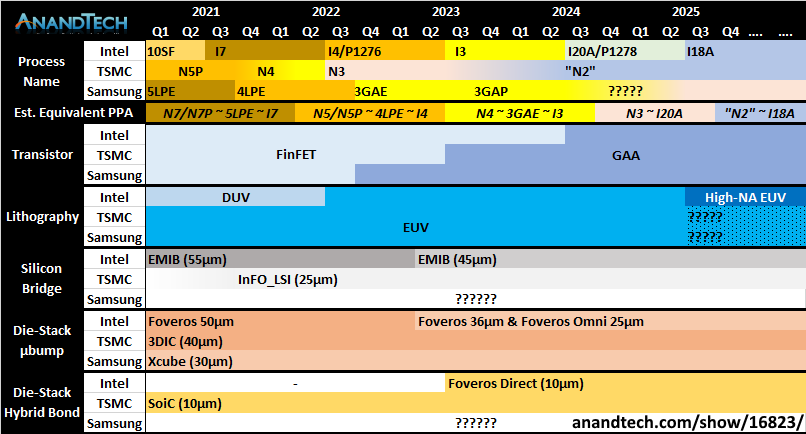Intel's Process Roadmap to 2025: with 4nm, 3nm, 20A and 18A?!
by Dr. Ian Cutress on July 26, 2021 5:00 PM ESTCustomers Customers Customers
As a roadmap announcement today, the focus isn’t so much on the customers but on the technology. Because Intel is moving into a phase where it expects its IFS offerings to compete against the established players, it has to consider its disclosures with respect to both its internal use and any external interest, which is a new concept for the company – at least on this scale compared to its previous foundry efforts.
Intel CEO Pat Gelsinger, in the company’s Q3 financial call last week, was keen to point out that they already have a large hyperscaler customer signed up for their next generation packaging technology, however today there would appear to also be another customer in the mix. Now we assume that Intel’s Foundry Services is talking to 100s of chip companies, big and small, but it doesn’t take much to sign an NDA to start to talk – what will be interesting is when customers start making commitments to using Intel’s facilities, and if any of those are volume orders.
As part of the announcement today, Intel held a little bit back from us, saying that they are saving some of the details specifically for the event that is going on as we publish this piece. All we know is that our draft press release has a big yellow bar that says ‘[customer news]’ on it, right next to Intel’s 20A process node details.
For reference, Intel 20A is a 2024 technology using first generation Gate-All-Around transistors, marketed as RibbonFETs, as well as backside power delivery, marketed as PowerVias. At this time Intel expects to have second/third-generation EMIB available as well as fourth-generation Foveros Direct. So if a customer is already committing to Intel 20A, there’s going to be a lot of potential here.
When the announcement is made, we will update this news article.
To conclude, Intel maintains that these roadmaps will showcase a clear path to process performance leadership* by 2025. It’s a tall order, and the company has to execute better than it has in recent memory - but that’s kind of why the company has rehired a number of former Intel experts and fellows in research, product design, and execution.
*as measured by performance per watt at iso-power
Here's a secondary comparison chart (compared to the one on page one) with all three main foundry offerings listed in each of the main segments that Intel has discussed today.











326 Comments
View All Comments
Spunjji - Thursday, July 29, 2021 - link
"TSMC can not satisfy the demand cause low yields"False. We know their yields, and they're good. They can't satisfy demand for many reasons, mainly that they simply don't have enough fabs, but also including literally running out of water.
mode_13h - Sunday, August 1, 2021 - link
> also including literally running out of water.I've heard about the fresh water shortage, but do we know this is actually impacting fab throughput?
zodiacfml - Tuesday, July 27, 2021 - link
wtf is this waste of time. they band-aid their problems with a name change? Intel 10nm is inferior to TSMC 7nm, as I found in their latest 8 core 10nm laptop chips vs AMD's. If you dont believe me, the clue is in TSMCs use of EUV in a few layers of 7nm products. TSMC is no engineering slouch and Intel can't beat physics by just using DUVKeyrock42 - Tuesday, July 27, 2021 - link
Regardless of the naming scheme, the problem for Intel is a lot less about deceptive naming by competitors and a lot more about being able to actually stick to their own roadmap. You can show me an impressively aggressive roadmap and that's all well and good, but my confidence in Intel's ability to stick to said roadmap is at about 2%.DougMcC - Tuesday, July 27, 2021 - link
Seems like the more straightforward naming convention would be based on the density, going ever upward. If the new process offers no advantage in density, you get +, ++ etc. for power improvements and whatnot.mode_13h - Wednesday, July 28, 2021 - link
Makes sense, but I think their 14 nm debacle spoiled the idea of using "+".I'd rather see sequential numbering for major advancements, with letter suffixes for minor ones. Or heck, maybe just a sequential versioning scheme like 2.1 for major.minor improvements.
Spunjji - Thursday, July 29, 2021 - link
That would be nice!six_tymes - Tuesday, July 27, 2021 - link
so many so called enthusiasts are hyper focused on process size, and unfortunately type comments that often read like that of a 12 year old. Most of these types of comments are called trolls, or trolling? What matters in processor technology are results, results in performance and stability. It looks as if this new Intel CEO knows what he is doing, and seems to be steering the ship back in the right direction. I am looking forward to this new competition he is bringing to the industry.diediealldie - Wednesday, July 28, 2021 - link
Can't agree more. Pat showed difficulties ahead and provided how they'll overcome that hardship using technologies only Intel has. He's also brought IDF back which made Intel a great company.It wasn't merely a 1~2 year hyped self-praise, but it was more like long term roadmap to be great again. People are saying that IDM's time is done, but who knows. There are things only IDM can do and Pat seems to know a lot.
mode_13h - Thursday, July 29, 2021 - link
> how they'll overcome that hardship using technologies only Intel has.Uh, the article repeatedly translates between Intel's terms for things and what equivalent or similar things other fabs are working on.